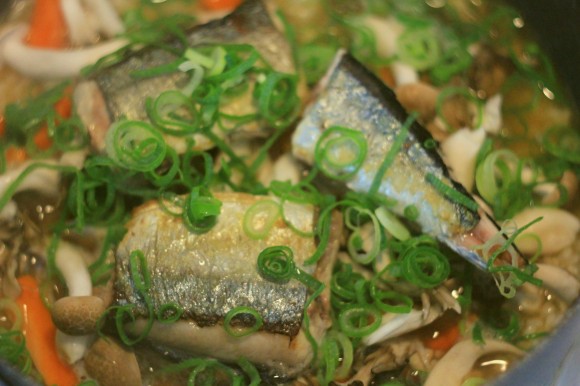So, I finally kitted out my kitchen here in Japan. After finding a store with off-brand utensils, I equipped my kitchen with the basics and stocked my cupboards for less than £50. Immediately, I wanted to begin cooking. What would my first home-cooked meal in Japan be? Japanese home cooking is seasonal, simple and healthy. With that in mind, there was only one ingredient I wanted to cook.
Sanma (秋刀魚, lit. Autumn Knife Fish) is a quintessential Autumn fish in Japan. An oily fish, not unlike mackerel, it puts on fat before the cold winters, becoming especially tasty at it’s peak in October. It is a homely, everyday food (and, at less than 100 yen each, rather cheap), usually rubbed in salt and grilled whole before gutting. This gives a distinct bitter taste, apparently (although you can’t taste it when gutted in this dish), which is the source of the name of Yasujiro Ozu’s famous 1960s slice-of-life movie The Taste of Sanma. If you can’t find it, mackerel or garfish will make a reasonable substitute so long as it is fatty and really fresh. The high omega-3 oils in the sanma enrich the rice like butter in risotto.
This dish is very simple to make. Seared sanma is placed with vegetables (carrots and seasonal mushrooms) on top of rice, covered in dashi stock and steamed until the rice is cooked. I served it alongside some miso soup with wakame and a umeboshi (pickled plum) on the side. My only error was not properly boning the sanma- I’ve rarely cooked fish, and foolishly decided to try and impress the lady in the supermarket by buying the fish ungutted and unboned. If you don’t like bones, make sure to pick through the fish thoroughly before mixing with the rice.
Sanma Takikomi Gohan (Serves 2)
1 Sanma (or small mackerel).1/2 Carrot.
Shimeji & Maitake mushrooms, large handful each.
1″ piece of Ginger.
Spring onions, 1 bunch.
Short-grain (Japanese) rice, 2 “cups” (through trial and error, I’ve found that a Japanese teacup is the right amount of uncooked rice for one person. I believe this is equal to 2/3rds of a US cup, but use your judgement- we want 2 person’s worth of rice) Water, 2 “cups”.
1tsp Granulated Dashi.
2 tbsp Soy Sauce.
2 tbsp Sake. Juice 1/2 lemon and 1/2 lime. 2 tsp salt.
1. Behead the sanma and remove the tail and fins. Using the back of a knife, scrape tail-to-head to remove the scales. Slit the belly and remove the guts. The sanma has no stomach to speak of, so this is surprisingly easy. Wash out the cavity and cut into 2″ (ish) chunks.
2. Rub the fish skin in salt and sear over a high heat for 1-2mins on each side. This will caramelise the flesh, adding flavour and bringing out the sweetness of the fish. Remove and put to one side.
3. Wash the rice in 2-3 changes of water until there is no more cloudy gunk in the pan. Drain and leave to stand.
4. Cut the carrot into two round halves, then slice into batons approximately 1″ long. Separate the mushrooms into individual pieces. Cut the onions into thin rings. Set aside.
4. Combine the soy, dashi, citrus and sake with the water and rice in a large pan with a tight-fitting lid. Cover the dome of rice with the carrots, mushrooms and fish. Sprinkle over 2/3rds of the onions.
5. Bring to the boil over a high heat. When there are bubbles rising from the rice, poke it a few times with a chopstick and cover. Immediately reduce the heat to low (if you are using an electric hob, remove from the heat whilst the hotplate cools down) and start your 15 minute stopwatch.
6. After 15 minutes, there should be holes poking out from the rice. Increase the heat and give the rice another minute of high before immediately removing the pan from the stove.
7. Take the sanma out of the rice and let cool slightly before removing the spine and small bones. Flake the fish (if you feel hard lumps, check again for bones) and add to the rice. Stir through to combine before garnishing with the remaining onions. Serves 2.

